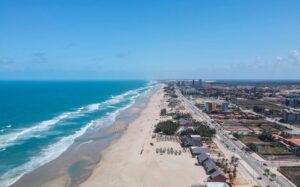A sand strip located in the Praia do Futuro, in Fortalezafulfills an essential role for the operation of Internet in Brazil. That’s where they are anchored 16 submarine cables opticalresponsible for almost 90% of international data traffic that enters or leaves the country.
Although we have more and more mobile networks like the 5g And to use cloud services daily, the base that supports the global internet is still mostly physical – and witched. Much of this system passes underwater, through submarine cables that connect countries and continents.
Fortaleza is an internet hub in Latin America
According to data from TelegeographySpecializing in Telecommunications Infrastructure, Fortaleza houses the largest number of submarine cables Latin America and occupies the 17th position in the world rankingbehind cities like Singapore, which leads the list with 28 cables.
“Fortaleza welcomes the vast majority of submarine cables that arrive in Brazil and concentrate close to 90% of international traffic that arrives or leaves the country”, He said ANTONIO MOREIRASProject Manager and Development of Nic.brentity that operates under the Internet Management Committee in Brazil, BBC News.
Geographic location is one of the main factors for this concentration. The capital of Ceará is among the Brazilian points closest to the United States, Europe and Africa. In addition, the Praia do Futuro It offers ideal conditions such as stable ocean bed, low sediment movement and infrastructure available space.
Another element that has been strengthening the position of Fortaleza as a technological hub is the renewable energy production in Cearáespecially solar and wind, which attracts investments in the technology sector and DATA CENTERS.
Data Centers and the dorsal spine of the internet
- BBC News Brasil, which held the report, visited one of the six certified data centers in Fortaleza, Angola Cables.
- The place works not only as a data storage center, but also as landing station for one of the submarine cablesspecifically what comes from Angola.
- The building, with 3 thousand square metersoperates under rigid security protocols. Restricted access, temperature and humidity control and prohibition of use of electronics are part of the routine of professionals working there.
- In addition to the date centers already in operation, at least Three new projects in Cearáwith investments that add R $ 2.1 billion.
- There is also a large project, budgeted in R $ 50 billionwhich will be built in the region of Porto do Pecém and has caught the attention of companies like Chinese Bytedanceowner of Tiktok.
- Questioned by the BBC, Tiktok stated that “It does not confirm or denied” The interest in the project.
- Already the Wind Houseresponsible for the work, said that the construction should start in the second half of 2025with operation of operation in 2027.
How data traffic works over the internet
You submarine cables They are, in practice, large digital highways. They connect data centers around the world, which work as true “Internet brains”.
When a user accesses content, the data travel a network of servers until it reaches the residence, passing by fiber optic cables and, only in the final meters, through the wireless network – either Wi-fi or 4g/5g. If the content accessed is not stored on a data center in Brazil, it travels thousands of kilometers via submarine cable, crossing oceans in a matter of milliseconds.
Data from Enisa (European Agency for Network and Information Security), passed on by Anatel to the BBC report, indicate that 97% of the data transmitted between continents travel through the submarine cables. Just 3% use satelliteswhich mainly serve for remote regions where there is no physical network.
Read more:
What if a submarine cable breaks?
These cables have an average service life of 25 yearsbut may be damaged before that. In coastal areas, repairs can be done by divers. In great depths, repair requires submarine robots or operations to bring the cable to the surface.
In the last two years, at least 11 cables were damaged in the Baltic Seaon suspicion of sabotage during the war between Russia and Ukraine.
If one of the cables of Praia do Futuro showed defect, users could notice impact, for example, in services that depend on servers outside Brazil, as a possible slow in the updating of movie and series catalogs.
However, much of the Brazilian internal traffic would not be affected, since between 70% and 80% of the data circulate within the national infrastructure itselfaccording to the Nic.br.











